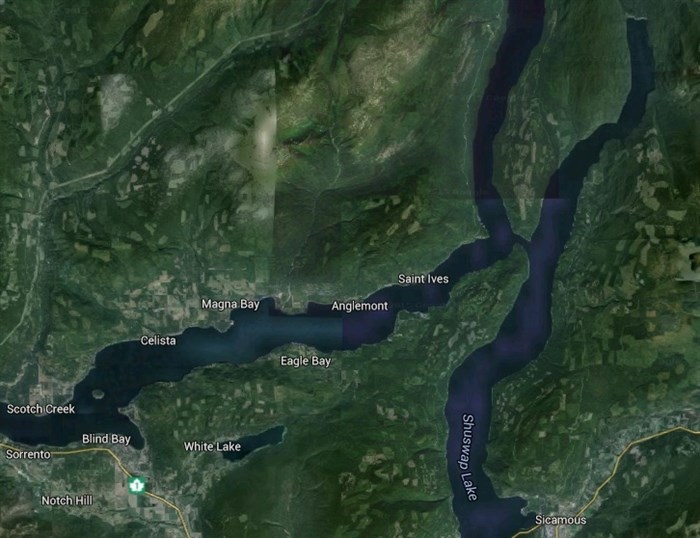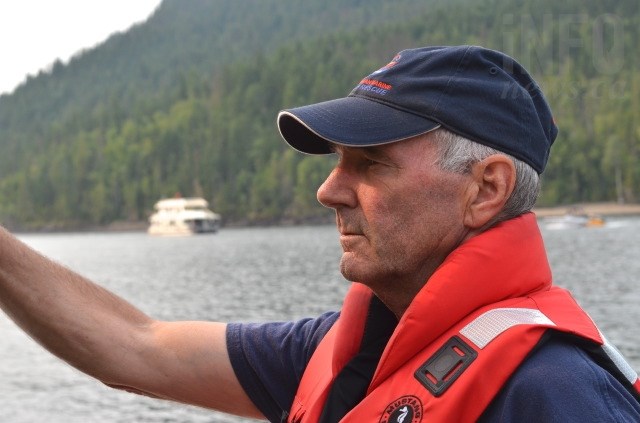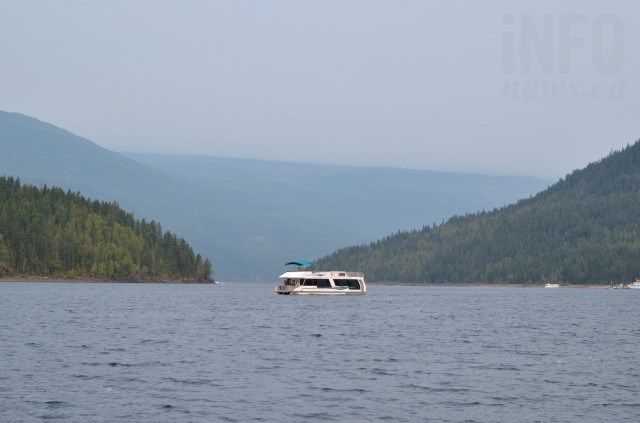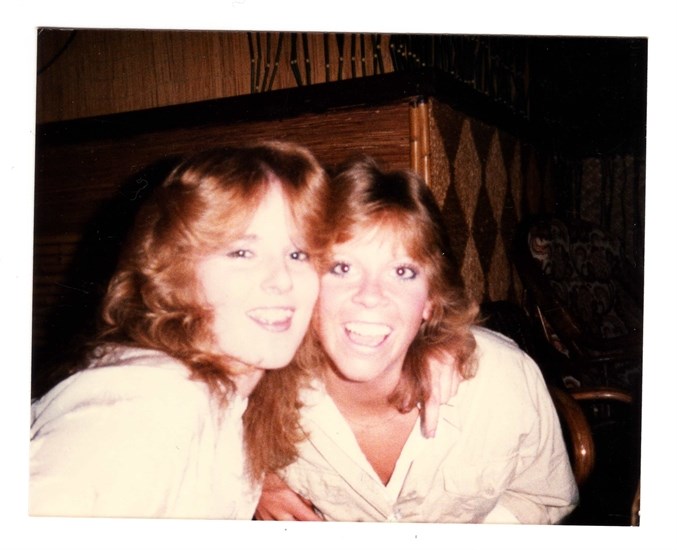
This video from 2014 shows a houseboat party on Shuswap Lake.
Image Credit: YouTube
August 31, 2015 - 9:00 PM
SICAMOUS - Andrea Jacura and Scott Glen both visited the Shuswap on rented houseboats this summer. Neither left alive.
Like the roughly 200,000 other tourists who descend upon the houseboat capital of Canada every summer, they were there to have a good time. Instead, Jacura, 22, from Alberta, suffered a gruesome death after getting sucked into a boat propeller. Less than a month later, Glen, 24, from Saskatchewan, jumped off a houseboat and didn’t come back up.
They aren’t the first lives lost — there have now been eight deaths on Shuswap and Mara Lakes since 2010 — and while police and rescue groups believe more responsibility must be taken by individuals, others are calling for changes to the houseboat industry itself to prevent another tragedy.
A TYPICAL DAY ON THE LAKE

The four arms of Shuswap Lake.
Image Credit: Google Earth Engine
A typical weekend in the summer will see hundreds of houseboats scattered around the four long tentacles of Shuswap Lake. The lake itself touches a number of different communities, including Salmon Arm, Blind Bay, Scotch Creek and Seymour Arm, and roughly 60-70 per cent of the surrounding beaches, hiking spots and marine parks are accessible only by water.
You’ll find houseboats anchored everywhere from quiet coves to notorious party spots like Nielsen Beach, a roughly two kilometre stretch of sand often crammed end to end with upwards of 100 houseboats. It’s a spot Royal Canadian Marine Search and Rescue volunteer Rob Sutherland finds himself often, though not for the usual reasons people visit; he shows up when things go sideways.
“Music is blaring, lights flashing, hundreds of people are having a great time in their mind, but there’s also great potential for accidents,” Sutherland says. “That’s one of our hotspots for sure.”
Station 106, the Shuswap branch of the rescue organization, was created four years ago in response to a growing need for emergency personnel on the busy lake. It remains the only inland water station in the province — the rest are all on the ocean. Of B.C.’s 38 stations, the Shuswap is considered one of the busier branches during the summer. In 2012, its first year of operation, the station responded to 44 calls. In 2013 it received 51 calls for service, in 2014 38 calls, and to date in 2015, 21 — a symptom perhaps of wildfire activity and the economy resulting in a slower houseboat season overall.

Rob Sutherland, a volunteer with Royal Canadian Marine Search and Rescue, overlooks the Cinnemousun Narrows, where the four arms of Shuswap Lake meet.
(CHARLOTTE HELSTON / iNFOnews.ca)
“We get everything from broken toes, to broken arms and legs, falls and cuts to searching for missing swimmers, you name it,” Sutherland says.
Overdoses, alcohol poisoning, and dehydration caused by drinking too much booze and not enough water are all common on the lake, he adds. Outfitted with radar and chart plotters allowing for 24/7 all-weather responses, the marine search and rescue group is called upon for most medical and distress calls in and around the water. The group, which is funded in part through the regional district, houseboat companies, and private donations, has been so busy its proven the need to add a second boat to its fleet.
The incorporation of marine search and rescue on the lake has made a big difference in what happens after an accident occurs, but prevention is another matter entirely. Houseboat companies provide orientation seminars before groups head out on the water, but Sutherland says not everyone heeds the safety protocols.
“There’s a shared responsibility, but the onus I think you have to put on the individual to think about what you’re doing first and act appropriately,” Sutherland says. “An outside agency can’t babysit you 100 per cent of the time. It can give you all the information, but if you don’t act properly it’s going to be dangerous.”
DOES ‘ALL THE INFORMATION’ PREPARE BOATERS FOR THE RISKS?

Prior to renting a house boat, visitors must participate in an orientation and sign a rental safety checklist put out by Transport Canada.
(CHARLOTTE HELSTON / iNFOnews.ca)
Transport Canada requires all boaters carry proof of competency — something which shows they understand basic boating safety rules and can safely operate a boat. The most popular form of competency is the Pleasure Craft Operator Card. But if you’re only renting a boat, Transport Canada spokesperson Melany Gauvin says you can obtain temporary proof of competency by completing and signing a rental safety checklist. Transport Canada developed vessel specific checklists including one for houseboats, as part of a pilot project in 2014.
“Renters can expect to receive a safety briefing from rental agency staff prior to taking any boat away from the dock,” Gauvin says. “Safety briefings are typically tailored to show the renter how to operate the specific boat being rented, how to use the safety equipment on board, identify the local rules, conditions, and hazards of the area where the boat will be operated, and review procedures to follow in case of an emergency.”
The safety orientation is something Danielle Fraser took part in before renting a houseboat with a group of friends earlier this summer. Fraser was on Shuswap Lake the same weekend as Andrea Jacura, and was in fact one of the strangers who tried to save her.
She describes the safety orientation, which she attended with her co-captain as roughly 30-45 minutes long. She and her partner attended the briefing with roughly half a dozen other designated captains and co-captains from other boats, and were responsible for bringing the information back to the remaining 13 people in their group. Requests for interviews with several Sicamous house boat companies themselves either declined or not responded to.
“I can't speak for everyone else but the houseboat they showed my co-captain and myself was completely different from the houseboat we actually got so we had to constantly go back to the operator’s manual and figure it out for ourselves,” Fraser says, adding they did get a quick demo on how to drive their specific boat. “I was a bit nervous setting off as they don't really tell you how it should be driven, they just draw a map on how to get out of the harbour.”
She remembers being warned no one should be at the back of the boat while it’s running due to carbon monoxide gas, not to jump off the roof, and to honk the horn three times before reversing. They were also told not to start the boat if anyone was in the water around them. But while the warnings were there, she feels the gravity of the risks were not adequately expressed.
“They didn't stress seriousness of boat safety or risks to the group except for the carbon monoxide gas that is released at the back,” she says. “Other than that there was no explanation of propeller safety or using a buddy system for when you're starting up the boat and driving it off which I think should be stressed.”
The seriousness became all too clear later in the trip when Fraser’s group met Jacura’s at Nielsen Beach.
“Andrea’s boat came over to ours to party. They yelled over to us and asked if we wanted to go down their slide,” Fraser says.
The next thing she remembers is seeing a guy playfully push Jacura off the boat while the motor was running.
“I saw Andrea try and swim away but get caught and pulled in. I heard the sound and I saw the blood in the water as (she) disappeared underneath,” Fraser says.
Everyone on Fraser’s boat were trained as lifeguards or emergency medical responders and rushed in to help. They cut off her cover up, which was stuck in the propeller, Fraser says, and attempted to apply a tourniquet to her leg, which was badly cut. They were unsuccessful due to the extent of her injuries. Jacura went unconscious in the water. The group eventually managed to get her out of the water and onto the back of the boat where they started CPR. Help came from the nearby floating sea store and they hooked her up to an Automated External Defibrillator and oxygen.
“We continued CPR until boat rescue came and at that point they did absolutely everything they could to bring her back but it was too late,” Fraser says.

Andrea Mary Jacura, 22, of Edmonton, Alberta died July 10, 2015, while house boating on Shuswap Lake.
Image Credit: Facebook
THE PROBLEM WITH BOAT PROPS
According to B.C. Coroners Service, deaths caused by boat propellers are fairly rare. Coroner Larry Marzinzik says all aspects of Jacura’s death will be examined to determine whether any recommendations can be made to prevent a similar tragedy, but couldn’t say specifically if propeller cages — which some suggest could be a solution — would be effective.
It’s something people like Sutherland of marine rescue have encountered before — the uncommon, but gruesome, injuries caused by those sharp, spinning propellers — and would like to see investigated. Over the past four years, Sutherland has seen three propeller-related accidents: one where a woman lost her leg, but lived, another where a man’s ankle was badly slashed but saved. The third, Jacura’s, was deadly.
“There’s a myth that propeller guards are the answer,” Sutherland says. “You can actually get wedged in between the guard and the propeller and if it doesn’t cut you, it will hold you under and you can drown.”
With an improved design, he believes guards could be effective. The problem is no one has really researched or tested any prototypes. Transport Canada has not performed any specific research on the use of propeller guards, but Gauvin says safety awareness about propeller strikes is one of the elements taught in boat safety courses.
It leaves Sutherland believing that for now, the only feasible answer to preventing tragedies is for individuals to take safety into their own hands.
“Go above and beyond (the orientation),” he says. “It sure doesn’t hurt. There’s all kinds of websites where you can get competency licenses, and higher levels of training through boating clubs. I’d recommend that. A lot of people come out every year so there’s nothing wrong with getting more information.”
ARE ACTIVITIES ON THE LAKE OUT OF CONTROL?

With 60-70 per cent of the lake accessible only by boat, the Royal Canadian Marine Search and Rescue group is kept busy throughout the summer months when some 200,000 tourists descend upon the water.
(CHARLOTTE HELSTON / iNFOnews.ca)
Every summer, Mara and Shuswap Lakes see an influx of roughly 200,000 tourists, and with that high volume, Sicamous RCMP Cpl. J.R. Lechky says accidents are bound to happen.
“The problem is you’re looking at policing a huge number of people on a huge area,” Lechky says. “If you’re wanting to make a direct correlation, you’d need hundreds of police officers out there.”
The detachment has one police boat, and throughout the summer officers hit the water on a weekly basis. But with the lake being so big, it’s entirely possible you won’t see them — or conservation officers, or reservist enforcement units (retired police officers) — at all, even if you’re out for days. But if those who do get checked during routine police patrols are any indication, most people are behaving themselves and following the rules, Lechky says.
“The compliance rate is actually quite high,” he says. “We find in most cases out on the lake that the person operating the boat is sober.”
Shuswap Lake has undeniably earned itself a reputation as a party spot — you only need to Google houseboat party on Shuswap Lake, or even just Nielson Beach, to find YouTube videos of rave-like parties. The lake bottom itself tells the story: divers searching for lost bodies report carpets of beer cans embedded in the muck.
Generally, mixing boating with alcohol is illegal, but house boats are a bit of a loophole. It’s illegal to consume liquor on a boat, unless it’s equipped with live-aboard quarters, the defining feature of a houseboat.
“It’s no different (legally) than being in a motorhome — you can drink in a campground and there’s no issues — except that if you fall out of your camper you land on the ground. If you’re drunk on a houseboat and fall off, you drown,” Lechky says.
Jumping off a house boat is exactly what police and the coroner’s service believe led to Scott Glen’s death. He was staying with friends on Mara Lake when, in the early morning hours of Aug. 4, he jumped into the water and didn’t come back up. Police believe alcohol was involved, but no definitive findings have yet been released.
Lechky says intoxication is at the root of most major incidents on the lake, and like impaired driving, believes most people know the risks involved with drinking and operating a motorized vessel.
“You can say all the corny, cheesy lines there are. It’s whether or not people choose to take that message to heart,” he says.
With two fatalities on Shuswap and Mara Lakes this summer — and a trial underway for a 2010 incident involving a speedboat that drove into a houseboat, killing a man — Lechky acknowledges the topic of safety is in the spotlight, but insists 99 per cent of people who go out on the water come back safe and sound.
“In general, is the lake safe? Yes, I would say it is,” Lechky says. “Most people are acting safely, it’s a small percentage that aren’t.”
But many insist even a single life lost is one too many. Diane Castle lost her best friend 22 years in a tragic house boating accident and is calling for change before the lake, and the industry, claim another life. She believes every single person should be required to participate in the safety orientation — not just the captain and co-captain — and insists the use of propeller guards must be looked at before it’s too late.
“Without a doubt, it’s going to happen again unless something changes,” Castle says.

Diane Castle, left, with her best friend, Christine Hingley, who died 22 years ago in a houseboat accident on Shuswap lake.
Image Credit: Contributed/ Diane Castle
To contact the reporter for this story, email Charlotte Helston at chelston@infonews.ca or call 250-309-5230. To contact the editor, email mjones@infonews.ca or call 250-718-2724.
News from © iNFOnews, 2015